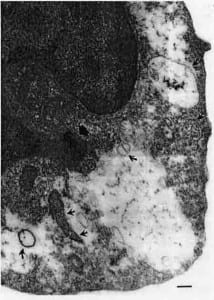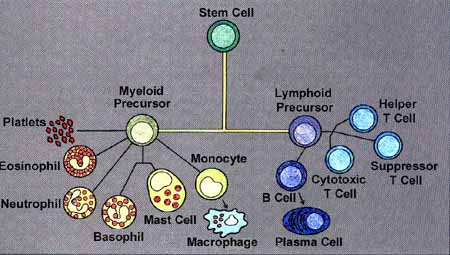Marshall Protocol (Immuno-Inflammatory Modulation In Chronic Disease)
When a bacteria or virus infects someone, inflammation occurs. The immune system responds by both attacking the invader and by multiplying. The expected result is that the infecting agent is eventually killed or contained. Sometimes, however, the invader outsmarts the immune system and learns how to live inside of the tissues that they have infected, or in extreme cases inside of the immune cells that are intended to kill them. The result is persistent inflammation and an ineffective immune response.

One such infection that has adapted quite well to living inside people is called Myoplasma. Most often Mycoplasma infections are not HIV or life threatening. In fact Mycoplasma can live inside people for decades without them ever even knowing it. This is not AIDS or HIV. Think of it more like a sinus infection that you never completely got rid of. When present however, this infection, like any other, can cause the body to have excess inflammation.
At Piedmont Physical Medicine & Rehabilitation, P. A. when laboratory is positive for Mycoplama we utilize portions of the Marshall Protocol to treat the infection if we think it is contributing to pain, weakness, numbness or even brain fog. Essentially instead of just using an antibiotic for infection, an antibiotic plus blood pressure medication is taken in combination to eradicate the infection. The antibiotic is not taken daily and the blood pressure medicine is only used if the patient can tolerate it.
In his studies of Sarcoidosis, Trevor Marshall, PhD, developed the concept of adding a high blood pressure medication to an antibiotic to eradicate Mycoplasma. This treatment regimen is now referred to as the Marshall Protocol. DO NOT assume that everything pertaining to the Marshall Protocol is necessarily relevant to anyone whose lab is positive for Mycoplasma. Many patients have mild disease and can be treated with simple measures.
“Depending upon your individual conditions, expect to be on both Benicar and an antibiotic for at least 3 – 6 months. New Vitamin D-25/D-125 ratio blood levels will be taken periodically to assess if the mycoplasma are being killed”.
While other anti-hypertensive agents can be taken when on Benicar, it is best to avoid diuretics because hypokalemia (low potassium) can occur. Beta Blocker anti-hypertensives are better alternatives then diuretics. Patients following the Marshall Protocol should learn to follow their own blood pressure. They may find that, once the body begins to heal itself, they no longer need their original blood pressure medicine.
In fact, patients following the Marshall Protocol may also learn that they do not need as much of the other medicines they are taking, such as insulin or thyroid. Patients who have responded to antibiotic protocol and thrombolytic therapy may find that the Marshall Protocol enhances their response to these interventions. Previous non-responders may now find these interventions successful.
“Once on Marshall Protocol for awhile, it may not be a bad idea to check blood levels for those on hormone replacement. As the bad guys are killed the body’s natural functions can improve.”
Keep in mind that there is mounting evidence that hidden and resistant infection, or an altered immune response, play important roles in numerous disorders. Examples include cardiovascular disease, rheumatic illness, neurological disorders, cancer, chronic pain, fibromyalgia and chronic fatigue.
Understanding the relationship between the immune and inflammatory systems, and your body’s pain can provide an opportunity for treatments that lead to relief, restore vitality and reverse the disease process. “Mycoplasma (the infection) is the bad guy. Vitamin D25 is a get out of jail card. Benicar and Avepro are the cops and antibiotics are the sharp shooters.”
The first step is to control inflammation. Diets low in carbohydrates, controlling blood sugar levels, and taking anti-inflammatory medications can all be useful. Every patient is different. Your doctor will tell you if any of these are important in your case.
The second step is to reduce the amount of circulating Angiotensin II. Angiotensin II is manufactured in the kidney and is excreted into the circulation when inflammation is present. It is intended to maintain blood pressure and decrease tissue oxygenation in an effort to isolate the infected or injured region. Think of closing fire doors in an attempt to stop fire from spreading. In this case, Angiotensin II is the door and the mycoplasma is the fire.
It turns out that the presence of a “fire door” is exactly what mycoplasma need to move inside of the immune cells. Once inside, the immune cells think the pathogen is self and leave it alone. The net result is that with Angiotensin II present the pathogens are actually protected.
“The first step is to take away the get out of jail passes (make sure Vitamin D25, especially Vitamin D25 (D2), levels are not too high). Next, bring in the cops (Benicar) to round ‘em up”
Benicar is a medication intended to block Angiotensin II. Benicar is FDA approved for the treatment of high blood pressure (not for the treatment of inflammation). In terms of lowering blood pressure, its blood pressure effect occurs when 20–40mg per day (once a day dosing) is taken. Taking more does not add anything further to the blood pressure effect.
One advantage of this drug is that it has been studied at doses as high as 320mg per day. Even at these higher doses, it has very few side effects or drug-drug interactions. In patients taking Benicar to weaken the ability of pathogens to hide, a dose of 40mg taken every 6–8 hours is recommended. This should be done only under a medical doctor’s supervision, and blood pressure should be checked on a regular basis. Titrating the dose (slowly increasing it) may be required.
Anyone taking Benicar for this purpose should be aware that, even with low doses, their symptoms (pain, fatigue, etc.) might get somewhat worse at first. The reason is that once Angiotensin II becomes blocked, the mycoplasma can no longer hide. As a result they move outside of the cell, back into the circulation. Once the immune cells see the pathogens, a new, more vigorous inflammatory response to kill them occurs. More Angiotensin II is released and the cycle starts over again.
If this worsening of symptoms becomes more severe (which is not the usual case) it is referred to as a Herxheimer reaction (named after the doctor who first described it). It is actually a good thing because it means your body is now fighting off the infection. The antidote is to take more Benicar!
“Unless you have a severe immune disease such as Sarcoid, there is usually not much of a fight when the mycoplasma are corralled by the Benicar cops. If there is a brawl, just bring in more cops”.
One important way to reduce the likelihood of a Herxheimer from occurring is to limit the amount of Vitamin D inside of your body. The primary sources of Vitamin 25 D are vitamin supplements, foods fortified with it (such as milk, cereals and bread) and shellfish or pork. Other foods with less but still significant amounts of Vitamin D include chicken and beef (in each case, free range is preferred). Ask your doctor if your lab work suggests you need to be concerned about this.
If you have been told to restrict your intake of Vitamin D then reading nutrition labels is important; if a food has 6% or more of Vitamin A, or any Vitamin C, then it also likely has Vitamin D in it (even if it’s not labeled). Other not so obvious sources include carbohydrates, refined oatmeal and Rolaids. If you are a sun worshiper then covering up, or wearing UV filtered sunglasses, can mitigate the impact from sunlight. While it takes alot of detective work to cut out Vitamin D completely, that is usually not necessary. The results of blood tests can be used to determine what percent reduction, if any, is needed.
Vitamin 25-D is converted by the kidney into Vitamin D-1,25 whenever inflammation due to a bacterial pathogen occurs. Vitamin D-1,25 stimulates stem cells — cells that have not yet decided what they want to become — into immune cells. Under normal circumstances, the idea is to increase the body’s ability to kill pathogens by increasing (proliferating) the number of immune cells available to do the killing.

“Depending upon your individual conditions, expect to be on both Benicar and an antibiotic for at least 3 – 6 months. New Vitamin D-25/D-125 ratio blood levels will be taken periodically to assess if the mycoplasma are being killed”.
While other anti-hypertensive agents can be taken when on Benicar, it is best to avoid diuretics because hypokalemia (low potassium) can occur. Beta Blocker anti-hypertensives are better alternatives then diuretics. Patients following the Marshall Protocol should learn to follow their own blood pressure. They may find that, once the body begins to heal itself, they no longer need their original blood pressure medicine.
In fact, patients following the Marshall Protocol may also learn that they do not need as much of the other medicines they are taking, such as insulin or thyroid. Patients who have responded to antibiotic protocol and thrombolytic therapy may find that the Marshall Protocol enhances their response to these interventions. Previous non-responders may now find these interventions successful.
“Once on Marshall Protocol for awhile, it may not be a bad idea to check blood levels for those on hormone replacement. As the bad guys are killed the body’s natural functions can improve.”
Keep in mind that there is mounting evidence that hidden and resistant infection, or an altered immune response, play important roles in numerous disorders. Examples include cardiovascular disease, rheumatic illness, neurological disorders, cancer, chronic pain, fibromyalgia and chronic fatigue.
Understanding the relationship between the immune and inflammatory systems, and your body’s pain can provide an opportunity for treatments that lead to relief, restore vitality and reverse the disease process.





